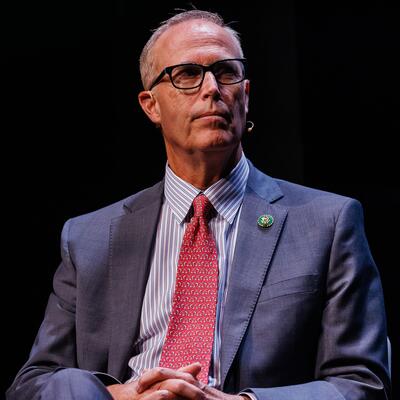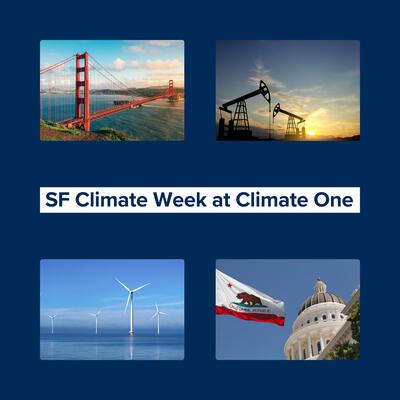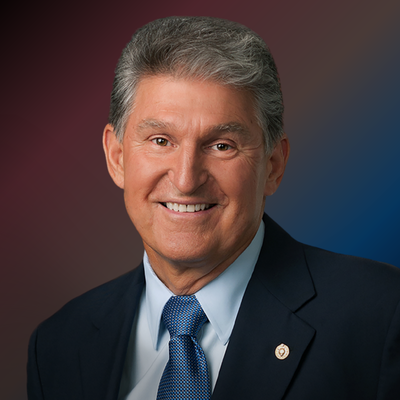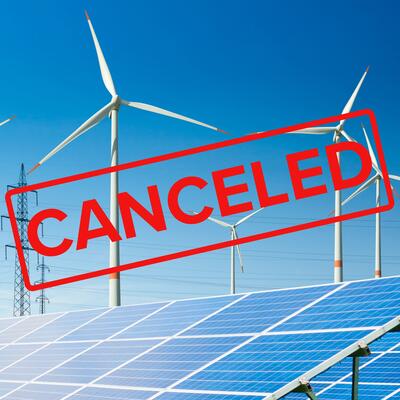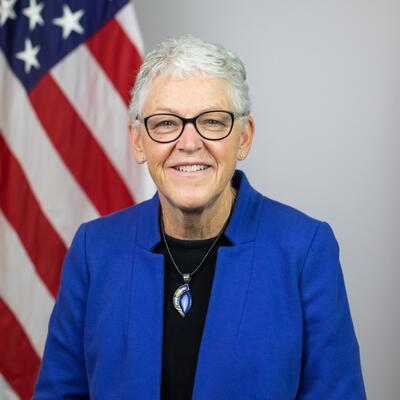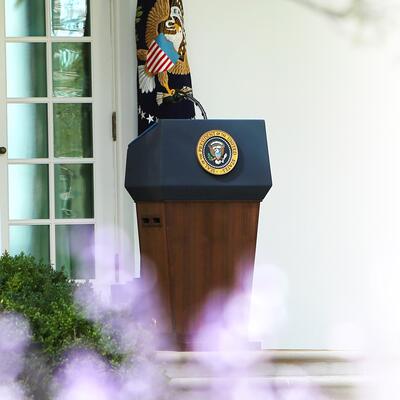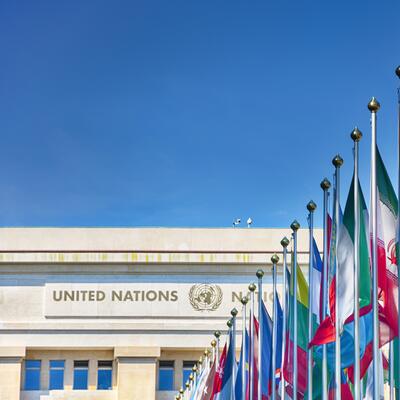
Tracking Trump’s Attack on Environmental Protections
Guests
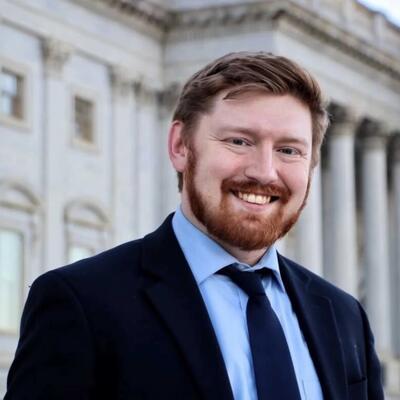
Sam Wojcicki
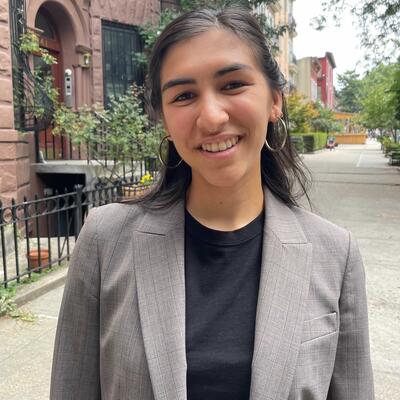
Olivia N. Guarna
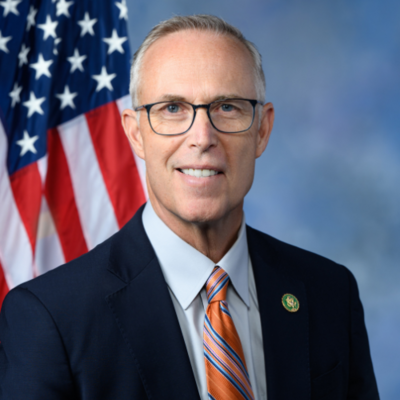
Jared Huffman
Summary
About fifty years ago, multiple environmental disasters, including the Cuyahoga River catching fire, forced a reckoning with how we care for the Earth. President Richard Nixon signed numerous environmental protection bills into law in the 1970s, including what is considered to be the nation’s green Magna Carta: the National Environmental Policy Act, or NEPA.
NEPA requires federal agencies to tell communities when they’re going to do something significant, like build a highway or open up land for oil leasing, and analyze the potential impacts of those projects.
Prior to NEPA, “neighboring communities didn't have a voice, and there was no process,” says Samuel Wojcicki, Senior Director of Climate Policy at the National Audubon Society. “People didn't understand what was happening until it was too late. And so really, NEPA is about that transparency.”
Currently, the Trump administration is taking aim at a slew of regulations across the federal government with a particular focus on undoing environmental protections. But unlike the big headlines about changes to social security or even the cuts to the Environmental Protection Agency, the revision of how to implement the National Environmental Policy Act has flown a bit under the radar.
NEPA has long been a favorite punching bag of pro-development and limited government actors who view it as a drag on economic interests. But Wojcicki says the Trump administration’s interim rule, which took effect April 11, could actually lead to further delays and challenges, like the requirement that 85 different federal agencies now have to create their own set of rules.
“That's gonna create uncertainty for infrastructure projects in the United States. It's gonna slow down permitting, it could lead to increased litigation and increased compliance costs for these companies,” says Samuel Wojcicki.
It can be tricky to push back against changes the Trump administration is making given the sheer volume of actions. But Olivia Guarna, a climate justice fellow at the Sabin Center for Climate Change Law, is trying to help by contributing to the Climate Backtracker.
The Climate Backtracker keeps record of the Trump administration's actions to weaken or eliminate federal climate protections, drawing information from primary government sources.
“ It's very chaotic environment right now,” Guarna says. “It's really hard to keep track of everything that's going on, and so just to have everything in one place is helpful for the public to understand and really grapple with what the administration has been doing.”
There are those within the government that are pushing back on the administration's attempt to claw back environmental regulations, like Congressman Jared Huffman, D-CA.
“ We gotta remind people that the entirety of the lawmaking authority rests with the Congress. The president has no lawmaking authority. None,” says Huffman.
He says there should be pushback from the public as well. “ I think all types of civic engagement are part of this. Showing up at town halls, showing up at rallies and protests.”
Episode Highlights
2:21 - Sam Wojcicki on why congress passed NEPA
4:07 - Sam Wojcicki on changes to NEPA
10:20 - Sam Wojcicki on the Fiscal Responsibility Act
19:31 - Jared Huffman on what worries him about regulation rollbacks
23:52 - Jared Huffman on the difference in Trump’s second term
41:07 - Olivia Guarna on the Climate Backtracker
54:00 - Olivia Guarna on if the damage can be undone
57:17 - Olivia Guarna on how the databases intersect with climate justice
What Can I Do?
Resources From This Episode (4)
Full Transcript
Note: Transcripts are generated using a combination of automated software and human transcribers and may contain errors. Please check the actual audio before quoting it.
Ariana Brocious: I’m Ariana Brocious.
Kousha Navidar: I’m Kousha Navidar.
Ariana Brocious: And this is Climate One.
Kousha, I’ve been thinking back on your recent interview with former EPA administrator Gina McCarthy, and how she talked about getting tarballs on her legs while swimming in the Boston Harbor as a kid. It stuck with me because that’s the kind of thing we don’t ever expect to happen today.
Kousha Navidar: Yeah, totally. I mean, not all of our waterways are pristine but they’re for sure a heck of a lot better than they were in the 1960s.
Ariana Brocious: And that’s not by accident. Americans started paying attention to how polluted some places were becoming, and seeing the harm in real time. There was this whole movement to start regulating industry to protect people and nature.
Kousha Navidar: Right, there were a few laws on the books but the 1970s were a banner decade for environmental protections. The Clean Water Act, Clean Air Act, establishing of the Environmental Protection Agency, and so on. All signed by President Richard Nixon!
Ariana Brocious: A Republican. Yeah because things got so bad it didn’t used to be controversial to want to protect our air, water, and public health. But over the years that’s changed. And right now President Trump is intent on eliminating or rolling back a huge number of these fundamental regulations. And one that’s really important and kind of flying under the radar today's show is the National Environmental Policy Act, or NEPA.
Kousha Navidar: This is kind of like our country’s environmental Magna Carta. A foundational law that requires federal agencies to tell communities when they’re going to do something significant, like build a highway or open up a bunch of land for oil leasing, and analyze the potential impacts of those projects.
Ariana Brocious: It’s a bedrock environmental policy. But now the Trump administration wants to change how the law is used in some pretty major ways that will likely end up hurting communities, air, water and wildlife.
Ariana Brocious: I invited Sam Wojcicki, Senior Director of Climate Policy at the National Audubon Society, to walk me through what the administration is doing. He reminded me of what spurred Congress to pass the law in the first place.
Samuel Wojcicki: why do we have nepa? as some people know, you know, kind of the famous story is that the Cuyahoga River in Ohio burst into flames. And then that really caused Congress and, the president at the time to really, have a conversation about what decisions are we making in terms of the deployment of energy, infrastructure, how is the federal government playing a role in this and making sure that the public had that information. You know, so really what we're talking about is anytime that a federal agency is making a decision that may impact a community, this can be permits for infrastructure that goes through a community. this is really about your ability to understand what your federal government is doing, and your ability to have your voice heard. you know, we've seen in the past how infrastructure kind of went in, , and you know, the federal government was able to just. You know, wholesale decide this is where a highway is going. and you know, really kind of exactly bulldoze communities go through those communities.
Those communities didn't have a voice. Neighboring communities didn't have a voice, and there was no process. People didn't understand what was happening until it was too late. And so really, NEPA is about that transparency and about that opportunity for a dialogue. With these kind of faceless agencies you know, ultimately NEPA can sound like jargon. It can sound like bureaucracy, I think to a lot of folks until they need it.
And that's the really important part, right? When it's your home that they're talking about, you know, bulldozing over and building a highway, that's when NEPA matters the most.
Ariana Brocious: Yeah. And we'll get into a bit of the bureaucracy and some of that, perception and the reality of that in just a minute. But so this has been around for decades. It's a foundational environmental law in the US and it really kind of. Undergirds a lot of other things. It helps us make these big decisions and the Trump administration wants to change the National Environmental Policy Act, how it's basically deployed. So let's walk through some of these changes. You wrote a very helpful blog summarizing some of these key changes. So first the idea is for each agency to create their own. Agency specific regulations, can you explain for an average person what this is gonna mean?
Samuel Wojcicki: Sure. At the White House, there's a small agency called the Council for Environmental Quality, or CEQ. Historically, the way this has worked is CEQ comes forward and kind of writes the rules of the road for how agencies should use NEPA. We're talking 85 plus agencies. So ultimately, CEQ sets the rules of the road, and then agencies will, you know, come out with very small regulations that decide some of the very specific parts to their work, right? What's being proposed here is kind of a rewrite of that process. And so instead of having one rules of the road that CEQ issues at this point, CEQ is saying we no longer are going to do that. And so we're actually gonna ask all 85 agencies to write their own rules.
Ariana Brocious: 85 agencies. I just wanna interrupt and say that's a lot. That's a lot of agencies to come up with their own new procedures.
Samuel Wojcicki: absolutely. What's frustrating here is, you know, when we're talking about 85 agencies who haven't done this throughout their time of implementing nepa, they may not have the staff to do this. they may not have the resources or the know-how, and so. That's gonna create uncertainty for infrastructure projects in the United States. It's gonna slow down permitting, it could lead to increased litigation and increased compliance costs for these companies. You know, it might even lead to some projects not moving forward.
Ariana Brocious: Yeah, and what is sort of ironic here is that a large part of the criticism for the National Environmental Policy Act for NEPA is that it's slow and takes a long time and, you know, is, is very bureaucratic. And so while the sort of intention perhaps, is to do away with some of this burdensome regulation, it's actually gonna probably slow things down further, so this new proposal gets rid of the requirement that agencies analyze cumulative impacts of a decision. So can you briefly describe why that's important?
Samuel Wojcicki: This really gets to the heart of what NEPA can do. When we're talking about cumulative impacts, what we're really looking at is, you know, agencies are making a lot of different decisions and there's a lot happening in the environment around these decisions. And so. Cumulative impacts is about making sure that we're not considering each decision being made, each permit for a piece of infrastructure in isolation, but actually looking at what the total impact could be. And, you know, we use the example here of, you know, you might have a, um. A transmission line located near a wetland that could result in small amounts of runoff and pollution that maybe on their own wouldn't be an a problem to the habitat or, or to wildlife there. But when you start adding up other infrastructure, all of a sudden there's a highway next to that transmission line, and then, you know, now we're adding, you know, economic development. All of a sudden you have a disappearing wetland or you have a lot of pollution, a lot of runoff. And of course this is really important when we start talking about toxicity, right? If we're. If we're looking at how we get to the point where a river caught on fire and was flowing, it wasn't even flowing. It was oozing like sludge. Well, that's because you make a lot of different decisions in a row without considering the kind of cumulative impact of all those decisions taken together. This is kind of the basis of why Congress made this law in the first place. And so it, it, it seems a little bit against the spirit of. good, effective permitting to not look at this really kind of core part of, how we can be responsible stewards and how we can make good decisions.
Ariana Brocious: Right. And this goes back to this idea that there are now gonna be 85 agencies making their independent reviews, , not a central authority guiding that process. And so there's a few other changes I want to touch on 'cause they're also very important. One is essentially excluding. Nearby communities from being considered in terms of project impacts on its face. That sounds problematic. I, I'm wondering if you can give us an example of some of the work you've done where, where this really matters. I mean, this is about protecting people and the environment. So if the communities nearby aren't being considered, what's that gonna mean?
Samuel Wojcicki: Yeah. Everything you've heard that's terrible about federal permitting not working well really starts because communities weren't at the table and what we've seen in recent years is that when communities are brought in oftentimes those, biggest concerns that they might have can be addressed by the developer at low cost or no cost kind of solutions. And what's more is, the community can find out ways that they can be a part of this project, right? We've seen community benefit agreements rise as this opportunity to get formal agreements between communities and developers to take some of the financial benefits of this project and reinvest them in the community. And you know, from Audubon's perspective, that can be great for conservation. But it can also mean things like, tangible benefits to the communities. It can mean a park can mean, real infrastructure that has benefits.
It can also mean an agreement to locally sourced jobs. So there's a lot of different ways this looks, but that's what happens when communities are a part of it and excluding them will not only not get to that place of kind of happy harmony with these projects, but also is going to result in a place where those public health impacts, those noise impacts, those pollution impacts aren't getting considered from a, from a human health standpoint as well, because the best experts are gonna be the ones on the ground who know how previous infrastructure has impacted their health.
Ariana Brocious: Yeah, the community benefits agreement is such an interesting thing that we have seen become more prominent and there's so many ways that that can help projects, as you say, become more harmonious with the community. In some cases, it just means that they get some of the power. If you're building a transmission line for solar energy, that community gets some of the solar, so they're benefiting directly from a transmission line through their community. So, you know, NEPA has become a favorite punching bag of pro development and limited government actors for a really long time. Even among middle of the road organizations, it's often seen as slow and sometimes excruciatingly tedious. By and large environmentalists support this rule. But even some of those groups say it's slowing down the transitions we need to make. And so, part of that does stem from insufficient numbers of people, insufficient staff of people who are supposed to actually be doing these analyses and underfunding agencies, and then them not having the personnel to carry them out in an efficient manner. And so. In the last few years, there have been changes put forward to NEPA that have accomplished some of the modernizing and improvements that critics say have been necessary for a long time. What have those changes been?
Samuel Wojcicki: So in recent years, Congress kind of came together and hammered out a compromise through the Fiscal Responsibility Act, which was overwhelmingly bipartisan. I think what first I'll say is really important to note here is that when we're talking about the Fiscal Responsibility Act, you know, this kind of overwhelming bipartisanship extend to reaffirming NEPA, and I think that that's really important. , but in terms of the changes that were made, you know, part of what you, you know, they looked at there was they set timelines for review. So, you know, when a project moves forward through NEPA, there are two levels of review and environmental impacts. Statement, which is the, you know, kind of more in depth, if there's really a concern that reaches a certain level, they're going to do an what's called an EIS environmental impact statement or an EA or an environmental assessment. You know, they set timelines there of two years for the more in-depth look and one year for the environmental assessment, really kind of making sure that agencies were, were following through. They encourage the use of what are called programmatic reviews. This is where you're looking at. For instance, there was one recently looking at solar infrastructure on public lands and really trying to understand, where can we prioritize these projects? Where are they gonna have the least impact? What kind of impact should we be looking for? And these can then go on to inform specific projects and specific permits.
Ariana Brocious: Almost like having a template, kind of.
Samuel Wojcicki: Exactly, exactly. They allowed project sponsors to prepare certain documents, they also set page limits on the review. Uh, and again, they also looked at categorical exclusions. So this is where there's something that we all have kind of agreed, or the agency has looked at and said, you know, this really doesn't have a human health impact or an environmental impact that's usually that large. and they say, you know, so long as it's under a certain amount you can basically use this, this broad based exclusion. So these are a lot of efficiencies that kind of folks had talked about for a long time. Some guardrails on how long and how arduous this process can be, that we're invested in through the Fiscal Responsibility Act. It wasn't enough, but it was a good first step.
Ariana Brocious: Right, and it seems like it's a bit too early to see how many of those changes will take effect. And then there's been this change of administration and a real, you know, 180 in terms of how this rule is gonna be implemented at all. And so recently the US Department of Interior announced it's going to fast track permitting reviews for fossil fuel and critical mineral energy projects normally. These environmental impact statements under NEPA take a year or more. They're now supposedly gonna take between two and four weeks, so What do you think those changes will mean in terms of how those projects might impact the communities around them and, and public health?
Samuel Wojcicki: While moving more efficiently than those timelines they set up can be a good thing. It's only good if the permitting is effective. And so I think our concern is that what the Department of Interior is doing, is attempting to use emergency powers to speed up the process without first ensuring that the resources are there to effectively permit in a way that upholds their core statutory responsibilities that Congress just reaffirmed. So, you know, from our perspective, it's important that agencies follow the law and not engage in permitting for permitting's sake. We don't want a rubber stamp permitting system, but we want a process that actually ensures that infrastructure is safe for communities, wildlife, and our planet. What we want to see is a process that better integrates that, but also moves, effectively and efficiently. And so. You know, ultimately we appreciate the focus on trying to get infrastructure built. , and Audubon is, is, you know, we have a hundred gigawatt goal through our clean energy initiative where we're trying to support a hundred gigawatts of clean energy and transmission by 2028. And that's directly at the project level. , but importantly, we talk about it being responsibly cited, and that means talking to communities. That means considering wildlife impacts. So we wanna move fast, but we don't want to, you know, break the system as we're doing so.
Ariana Brocious: Mm-hmm. Separately from the National Environmental Policy Act, but in a kind of related sphere, the Trump administration has also proposed a rule changing the definition of the word harm in the context of the Endangered Species Act. So as it stands now, that word encompasses a lot of things.
It includes the destruction of habitat as a kind of harm. The proposal is to limit that to only really include intentional killing or injury If that rule moves forward, what will it mean for the work of groups like Audubon?
Samuel Wojcicki: I think it's hard not to say that, that that wouldn't be, , detrimental ultimately to our, to our conservation work. From our perspective, it's really important that we follow both the letter of the law and the spirit of law, , and really look at what has Congress said here.
, and purpose of the Endangered Species Act is to. Is to preserve the conservation of these critical species and to, to rebuild our ecosystems, and so ultimately, you know, that is the approach that, you know, we believe any administration should be taking, is to really uphold that core stewardship and conservation.
Ariana Brocious: Yeah. You know, I think with so many environmental rollbacks coming out of this administration, it's easy to feel overwhelmed and maybe that there's not much that can be done in the face of this emergency declaration and so forth. What can be done in your mind to kind of continue to move forward and try to protect these things that we value so much.
Samuel Wojcicki: Congress has a role to play here and, and it's our hope that that congress will, will step up and play that role. You know, we have seen, going back to NEPA, we have seen that the reforms that they just made through the Fiscal Responsibility Act we're starting to work. We watched as between 2019 and 2024, the median time for a federally prepared and environmental impact statement fell from 3.6 years to 2.2 years. That's a huge fall. The DOE had cut environmental timelines in half for EISs. DOT cut their time for environmental assessments by a third. These are are really meaningful changes that were happening and they were happening while keeping communities and wildlife organizations and public interest organizations at the table. And so, you know, we think that Congress enabled those reforms and it is up to Congress. To speak very clearly and protect the work that they've done. Outside of Congress, you know, what else can be done? Audubon works at the project level. And what we are seeing that I think is kind of the silver lining, and we talk about this all the time, is that. There is a sincere economic motivation, for kind of good clean energy and transmission projects. There is an economic motivation to working with communities regardless of what the rules are. And while I, I'm not, you know, kind of being naive and saying that that's gonna happen regardless, we do think that there's an opportunity to continue to work with developers to get responsible development. Get development that we need to meet the, you know, the climate crisis as quickly as possible in terms of clean energy.
you know, there are state analogs to NEPA, there are state analogs to a lot of the environmental protection laws that we see at the federal level. And so. this may be a case where states can really step up and, you know, fill in those gaps. And they still have control over the sighting of infrastructure, even if they don't have the ultimate control over the federal permits. So they have state analog permits that matter for some of these projects. And so, you know, we are working with states to make sure that those protections stay in place while also recognizing there are opportunities here for improvements.
Ariana Brocious: Sam Wojcicki is Senior Director of Climate Policy for the National Audubon Society. Sam, thanks for joining us on Climate One and sharing your expertise on this very complicated and wonky world of NEPA.
Samuel Wojcicki: Absolutely. Thank you for having me.
Kousha Navidar: Coming up, this administration is dead-set on eliminating climate and environmental regulations, but some people are pushing back:
Jared Huffman: We've just gotta make this an all inclusive, unified effort of people who love this country right now and we just don't have a lot of time for division.
Kousha Navidar: That’s up next, when Climate One continues.
Ariana Brocious: Help others find our show by leaving us a review or rating. Thanks for your support!
This is Climate One. I’m Ariana Brocious.
As the Trump administration tries to roll back decades of climate and environmental regulations, some lawmakers on capitol hill are pushing back. One of those people is Congressman Jared Huffman. He’s been in the House for more than a decade, representing California’s second district from the Golden Gate Bridge up to the Oregon border. He’s currently ranking member of the House Natural Resources Committee.
Huffman spoke with Greg Dalton on the Climate One stage during San Francisco Climate Week.
Greg Dalton: Lot's been going on, lots to talk about for sure. I think Bloomberg summed it up with a headline, “years of climate action demolished in days.” There's so much going on aimed at public health, greenhouse gas emissions just everywhere. How do you keep track of it all and what's most on your mind?
Jared Huffman: Unfortunately I have to try to track all of it and that, you know, could consume all my efforts just in the climate space. But I've got, you know, the rest of the jurisdiction of the House Natural Resources Committee now that I'm the ranking member. Mm-hmm. And then I've got the broader attacks on our democracy and the economic chaos. So it is a lot. All of us are having our bandwidth tested.
Greg Dalton: That's the point.
Jared Huffman: Yeah. I think it is the point.
Greg Dalton: Yeah. So there's some who say that there's this weapons of mass distraction, that some of what we're seeing is like, flash over there, you know, look over there. 'cause I don't want you to look over here. How do you know what to focus on?
Jared Huffman: I haven't found a formula that I can articulate yet, but I think you have to take these things one at a time and, uh, you, you know, you kind of figure out that maybe the fight over renaming the Gulf of Mexico is not, you know, where we ought to put all of our effort, but there's some other stuff that we need to take very seriously, and I would argue that the, the things that are fundamentally focused at tearing down our democratic institutions at establishing awful new precedents, such as what he's doing on immigration policy, his efforts to target political opposition. I mean, these are all major steps on the path to totalitarianism and I, I sort of give those highest priority.
Greg Dalton: Right. I've been working on climate for almost 20 years and have said, often said like climate's sort of the meta issue, It's like, if we don't have a stable climate, you don't have welfare, lots of things. And I'm actually more worried about democracy than climate. In some ways.
Jared Huffman: I'm right with you. I think right now the biggest climate issue is democracy.
Greg Dalton: There's a business case for, for clean energy. It is cheaper. It can be profitable. It's, it's clean, it's better in so many ways, clean energy. The business case for democracy is a business case on the other side, which is like you can make money, Undermining democracy, with less democratic ways. That worries me.
Jared Huffman: Some people are getting fabulously rich at it, aren't they? Yeah.
Greg Dalton: Yeah, they are. Among the actions that's happening is the National Environmental Policy Act, something that is a little bit wonky. But it's a 55-year-old law that directs federal agencies to consider environmental and cultural impacts from new development projects. Now each agency is being asked to kind of look at it differently. Tell us why we should care about this. Why does it matter?
Jared Huffman: Right. Well, I mean, I could take you back to the, the bad old days of the 1960s and seventies when we didn't have some of these bedrock environmental laws, and there's probably a few people in your audience old enough to remember when we pronounced entire bodies of water like the Great Lakes devoid of aquatic life and never fishable again. When we were losing iconic species like our, our national bird, the bald eagle because of DDT and so many other things. Um, so these foundational environmental laws that were bipartisan, uh, when they passed, most of them in the 1970s have really given us tremendous progress in, in the fight against that environmental destruction, but, uh, they've always had opponents and right now there is a lot of energy behind tearing them down. Uh, and certainly Donald Trump is, doing that in, in every way that he possibly can.
Greg Dalton: Is there anything that states can do? You know, what's the what's, what's the protection for that?
Jared Huffman: Yeah, a state like California can and, uh, can do a lot and, and has done a lot. We've got state laws that mostly mirror all of our federal environmental protections, and in many cases go further. And in some cases we had state laws like the Porter Cologne Water Quality Act, before we had the Federal Clean Water Act. So California has always been a leader in this space. The problem is, water pollution doesn't stop at state boundaries. Air pollution doesn't stop wildlife move and go and without regard for state jurisdiction. So you really do need national standards and national laws to protect these natural and national resources.
Greg Dalton: Right. And we've seen, you know, obviously in the first administration there was sort of, you know, attempts to, to shrink, uh, the EPA, these institutions can come back, that's a lot of what, you know, Biden tried to do is, you know, but is it different this time? What's happening in terms of the, you know, approach to the EPA and others? We didn't have Elon Musk last time.
Jared Huffman: Yeah. It's just different in every way. look, I've been fighting. Republicans in Congress on some of these issues for as long as I've been there, and I'm in my 13th year now in Congress. So the, the attacks are not new, but the, the tactics and the ferocity, uh, and the impunity with which they're being advanced, that is new. I mean, Republicans that I have been working with used to. Have some limits to where they would go. They wouldn't call for out outright repeal of things like the Endangered Species Act. They would say they supported all of the above energy portfolios. Look at what we're dealing with right now. I mean, Donald Trump has declared an energy emergency, a fake energy emergency at a time when we're producing more energy of every kind, that we ever have more fossil fuel exporting. I mean, we're, we're setting all kinds of records, but he's declared this crisis, this emergency, and then used it to try to fast track only fossil fuel projects.
Greg Dalton: Because that emergency power gives him more power.
Jared Huffman: Exactly. Yeah. And so just this week they announced that they are gonna pretend to reduce federal permitting for fossil fuel projects to just 28 days under this emergency that they have declared, and you know, my feeling is I hope big oil is stupid enough to try to take advantage of that new permitting avenue that the president is attending 'cause they will get sued and they will lose.
Greg Dalton: Well, but even, you know, the head of ExxonMobil has said, we're not looking to expand supply right now. 'cause oil is what, $60? You know not necessarily, . gonna put a bunch of capital at risk market where it is. So he, even though, you know, the US government can say these leases are are available, it doesn't mean anyone bids on 'em, doesn't mean anyone puts in there.
Jared Huffman: We are awash in fossil fuels. There is no crisis, there is no emergency, there is a climate crisis because of all this fossil fuel extraction and burning. And that's really the problem. That's, that's the moment that we're in.
Greg Dalton: EPA administrator Lee Zeldin has announced his agency will reconsider the so-called endangerment finding a 2009 conclusion that carbon dioxide pollution endangers human health and welfare. This is the basis of many climate regulations. It's, you know, it's based on a Supreme Court decision, Massachusetts versus EPA. So what does it mean if he succeeds in getting rid of the endangerment finding?
Jared Huffman: Yeah. We have to find a better term for this endangerment finding because it sounds so esoteric to most people. But what it really means is that carbon pollution is bad for people and bad for the environment. And that's like self-evident to anyone who listens to the science.
Greg Dalton: It seems like RFK said sugar is poisoned. They need to borrow some of that, right?
Jared Huffman: That's pretty straightforward.
Greg Dalton: Right?
Jared Huffman: But yeah, this, this was affirmed, upheld by the Supreme Court previously. It shouldn't be controversial at all. And to try to take it away, now that should be wildly controversial and of course that will be fought mightily in the courts. And the question is, you know, whether some of these conservative justices will reach a different outcome this time.
Greg Dalton: Right. Just seems like there's this, there's this, the, the time offset is like, so much is happening so fast and like the courts are like this sort of like chasing after the bus after it's long gone. So how do you deal with, you know, the timeframes of the courts so slow, the executive branch through these imperial edicts moving so fast?
Jared Huffman: Yeah. Time is probably the, the most vexing part of this whole challenge because we're not just in a race against carbon pollution because of what it's doing to the planet, and the fact that it's gonna pretty soon unlock all kinds of terrible feedback loops that will make it even harder to stabilize the climate. But we have a narrowing window of time to stop it. And when we, when these guys run out the clock in all of these different ways, when they try to rewind the clock by making coal great again and doing all of these things that you're seeing from this administration, they're not gonna be successful in the long term, but they're going to take time away. And that really hurts our ability to do the right thing.
Greg Dalton: So we've been following kind of the, there's this talk about taking a scalpel to the Inflation Reduction Act or a sledgehammer because there's been Republicans from New York and elsewhere who said, oh, slow down. You know, keep that in place. What's the timeline? How's that gonna play out?
Jared Huffman: What it'll probably involve is trying to auction off a bunch of public lands to make some money for their billionaire tax cuts. It'll probably involve putting a big thumb on the scale for a bunch of fossil fuel development and then trying to pretend that that'll bring a bunch of revenue in to help pay for the tax cuts. But there'll be a lot of action in other committees and, and it'll be in the Ways and Means committee where those tax credits get fought out. And we're about to find out, you know, we've got 20 or so House Republicans that have written a letter with some wiggle room in the letter saying that they do not wanna do away with those IRA tax credits, but it's not clear to me that, you know when Donald Trump leans in and starts twisting arms, that those guys will stand their ground. You could imagine some of them defending battery storage and some other things because manufacturing has located in some of their districts. Certainly some of them like biofuels, a lot of them like the carbon capture stuff. 'cause that's not even a climate solution. That's basically an oil and gas giveaway. So, you know, it's a real mix and it will be interesting to see what's left standing at the end of that.
Greg Dalton: And then the goal is to extend the 2017 tax cuts, right? And to find the money to pay for that. And so what's the timeline? Is that something that's gonna happen before summer recess? What's the time horizon?
Jared Huffman: They've said before Memorial Day and I, I do not think they're gonna meet that deadline, but certainly things are gonna heat up in the house very quickly and we're gonna get very busy on it.
Greg Dalton: Right. So we're talking a lot about the bad things that are happening, though there are, you know , certainly questions. The Democratic brand is pretty tarnished right now. People are wondering –
Jared Huffman: I've heard about that.
Greg Dalton: Where are the Democrats? David Brooks, conservative columnists of the New York Times recently wrote that the administration is like a supercar with a thousand horsepower and Democrats are like scurrying around on mopeds. So what do the Democrats stand for now? It's easy to say, We're against him. But what does the party and you stand for?
Jared Huffman: Well, look, the, the Democratic party, those words always, you know, make me bristle a –
Greg Dalton: It’s a big coalition.
Jared Huffman: It is a complex organism and I am a small fiber in that organism, but all I know is that I have some fellow Democrats that I serve with that I think stand for all the right things and are great champions and great messengers, and I see so much courage and leadership from them every single day. The public clearly is seeing something else or wanting to see something else. And, you know, I, I don't really know how to answer that except to explain that we do not have a singular strong man leading our cult like the Republicans do.
Greg Dalton: You don't have even a leader at all.
Jared Huffman: We don't have any, because we're not in a presidential cycle. It's probably a year or two before we even have a strong sense of who the leading candidates for president the next time around are gonna be in the Democratic Party. So, I hope people will look to some of the great leadership. I think Hakeem Jeffries is doing a great job. I think my colleague Jamie Raskin, who I had in my district for the last couple days, is a phenomenal leader and a great messenger and we've got so many other colleagues. I think Chris Murphy is out there doing amazing things and, and there's others. I could go on and on. There's no lack of –
Greg Dalton: AOC and Bernie Sanders –
Jared Huffman: AOC and Bernie are bringing fantastic energy. To the country at a time when we really need it. So it's gonna be, I think, a platooning, a team effort from the Democrats here for the next couple years. And I hope people stop, you know, longing for that messaging Messiah to sort of deliver us from all of our angst. It's a little more complicated than that.
Greg Dalton: More than 500 political scientists recently filled out a survey saying the US is moving swiftly from liberal democracy towards some form of authoritarianism.
Jared Huffman: Absolutely.
Greg Dalton: And, and your Democratic party elected kind of a status quo guy to, you know, to lead it. Right.
Jared Huffman: I don't know anything about the DNC chair or you know how to characterize that. All I know is that my congressional Democratic colleagues and I are fighting this tooth and nail in every way we can. We are in the courts where we, where we have standing and can be, we are working with litigants who do have standing and are in the courts. We are monitoring compliance with the 70 plus court orders that we've had that in one way or another have checked Donald Trump's power. We are at rallies and protests and trying to use every bit of our platforms and communication tools. and we're using the limited tools we have in the minority in Congress, the parliamentary mechanisms, the spotlight of our hearings and the bills we introduce and the messaging we do. So the will and the fight is there, we've just gotta make this an all inclusive, unified effort of people who love this country right now and we just don't have a lot of time for division and, and I think hand wringing and recrimination.
Greg Dalton: Right. And then the idea is that like people haven't seen, this is David Brooks calling for, you know, this kind of sort of uprising and he's saying trans-partisan, it can't be the usual sort of left right, can't be just Bernie and a OC. 'cause that, that seems like the typical kind of Oh yeah. It's partisan. That's like politics as usual. And many people are saying this is not politics as usual.
Jared Huffman: It's gotta be bigger than that.
Greg Dalton: But what's lacking is something that people will give themselves up for that as Brooks has been saying this, we need to not just say, oh, this is bad. What are we for?
Jared Huffman: I think that we are starting to see, and, and in the weeks and months ahead we'll see even more how the breakdown of our democratic checks and balances and the erosion of our institutions actually does translate to things that hurt people. I don't, I take no joy in that. I think it's gonna be awful, but you're gonna see it in so many different ways, and it's gonna start to threaten and hurt people in very direct ways where the dots will connect and, and it should, it should happen. I hope it happens quickly.
Greg Dalton: Mm. So I want to talk about NOAA. Most people that you know, think what it's a, you know, biblical character. What's Noah?
Jared Huffman: The other NOAA.
Greg Dalton: The other NOAA. People haven't, you know, heard of NOAA, but if you look at your phone app to what, what clothes to wear, or, you know, logistics companies rely on data from NOAA to like, is your package gonna arrive on time? Um, so, so tell us about what's, you know, happening at NOAA and why we should care.
Jared Huffman: Yeah. NOAA is one of those federal agencies that does so much for Americans every single day that they really have no idea. So yeah, weather is like a big one because all of the climate data, all the climate science that we do, uh, at the national level, it resides at NOAA and so many of these data sets and tools that they develop and maintain are just made publicly available to everyone. So when you go to weather.com or when you see your weather forecast and the nightly news that's all coming because of NOAA. And it's accurate because of NOAA. When you get forecasts and mapping for hurricanes and storms and when you get warnings for red flag conditions, for fire dangers so that we can avoid catastrophic wildfire, that's all Noah science and no expertise that's making that possible when your nuclear submarine does not run aground. Because we've done good ocean mapping and because we understand ocean currents, that's because of Noah. And I have been at hearings where Navy admirals have made that case very passionately. So this is an agency that does such mission critical things for Americans every single day. And these fools from DOGE who don't understand that are just ransacking through the data cutting things and cutting people that they really fundamentally just don't even understand.
Greg Dalton: You know, we've been hearing about permitting reform for, for a number of years. This was supposed to be an area where Democrats want transmission for renewables. Republicans want oil and gas pipelines. Let's open it up and we can each kind of have what we want. Hasn't happened. Where is it?
Jared Huffman: Well, there, there's still a lot of conversation about it. What might change the conversation is frankly all of this new demand we're seeing from AI. So where this got bogged down in the last Congress was that most Republicans really didn't want to do energy transmission. They wanted to do pipelines, and that was their notion of permitting reform, it's fossil fuel all the way. And they were kind of threatened by energy transmission and FERC reform and other things that are holding back clean energy because they want their fossil fuel stuff.
Greg Dalton: And FERC is the Federal Energy Regulatory Commission that governs cross state transmission of energy.
Jared Huffman: Yeah, exactly. But with all of this demand from AI, I think even those Republicans are starting to acknowledge we're, we're gonna have to do a lot more transmission upgrading just to meet that demand
Greg Dalton: Because of the data center demand. Okay.
Jared Huffman: Yeah, so I think maybe there's a little bit more of a bipartisan flavor to the transmission piece of permitting reform. The problem is they still wanna just open it wide open for fossil fuel in ways that should be deeply troubling to anyone that cares about the environment or some of these disadvantaged communities that always bear the brunt of fossil fuel pollution or the climate crisis because, you know, they might even say, we're gonna make it technology neutral, do all this permitting reform, but they're doing all this other stuff over here to kill off clean energy.
Greg Dalton: The question often comes up in climate conversations. What can I do? People are overwhelmed right now over, you know, some people are just checking out, some people are activating. One person I heard says the best thing you can do is adopt a local institution, you know, a civic institution because a takeover would have to happen at the local level. What's your answer to? People ask you, Congressman, what can I do?
Jared Huffman: Well, the one thing you definitely should not do is while in the pit of despair, or be alone. I mean, that's kind of what they want. The authoritarian playbook is to divide us and overwhelm us and to fill us with fear and intimidation and existential angst. So, look, we all feel some of those things. It's hard not to with the fire hose, the flood the zone that we've been dealing with, but we gotta pretty, pretty quickly, get in a mindset of powering through this thing
Greg Dalton: Together.
Jared Huffman: Together. Yeah, it's gotta be a big engaged coalition. And I think the local stuff does matter. I think all types of civic engagement are part of this. Showing up at town halls, showing up at rallies and protests, showing up at a Tesla dealership, whatever is your, you know, sort of flavor of engagement. And then I'll just throw out one more thing. Support the big national environmental organizations because right now they are in the crosshairs. And you, you see what Donald Trump is doing to all of his political enemies. You see how he's going after higher education. You see how he's going after the law firms and individual judges. The big climate groups, the big environmental groups have a target on them right now. And he and Republicans in Congress are gonna be coming after their tax exempt status. They're gonna be doing so many things that put them back on their heels and they're gonna need our support too.
Ariana Brocious: Coming up, while the Trump administration is making bold moves to roll back climate policy, actually changing laws might not be that easy.
Olivia Guarna: It's not to say that I don't think that the administration intends to make good on the plans that it's announced, but there's still a long way before laws and regulations are actually changed.
Ariana Brocious: That’s up next, when Climate One continues.
Kousha Navidar: This is Climate One. I’m Kousha Navidar.
Ariana Brocious: And I’m Ariana Brocious.
Kousha Navidar: Ariana, I don’t know about you, but for me it’s been really difficult to keep up with all the changes the Trump administration is making to…well every part of government, but especially climate policy.
Ariana Brocious: Yeah, I’m right there with you, and I think that’s on purpose. They are trying to overwhelm us so that it’s hard to focus on any one thing.
Kousha Navidar: Totally. But thankfully there are tools out there that have helped me keep up to date on what is happening to climate laws. One of those is the Climate Backtracker. Olivia Guarna is a Climate Justice Fellow at the Sabin Center for Climate Change Law who manages the Climate Backtracker.
Olivia Guarna: So for the climate back tracker, we draw information from primary government sources. Um, so that can include anything from White House Announcements, agency, press releases, anything that's published in the Federal Register, which has things like final rules, proposed rules, notices from agencies or the White House executive orders, memoranda from agencies or the White House, all these sorts of things.It's based on government primary source material. Although sometimes updates will come to our attention through the media first because, you know, some news breaks there first before it's announced on agency websites. But we always try to do that sort of verification, with the government sources.
Kousha Navidar: What was the moment for you when you felt compelled to start compiling things? Was this something that you took on yourself?
Olivia Guarna: No. So the climate back tracker is actually part of a much longer standing project by the Sabin Center. We relaunched the climate back tracker specifically on inauguration day, but it was sort of the, I think the third iteration of these kinds of trackers. We wanted to keep track of, you know, federal climate related regulation and we started doing this in the Obama administration. We launched the Climate deregulation tracker at the first Trump administration, and then we launched the Climate Reregulation Tracker for the Biden administration. And then again, the climate back tracker. And all of that data is still available on the Sabin Center's website. We call it the Climate Regulation Database. But yeah, it's part of a sort of longer effort to keep track of climate related regulation or deregulation and identify trends, things like that.
Kousha Navidar: Can you take me back to Inauguration day just for like, you as a person when you're sitting there and, and you say that you're, you're relaunching it. Like what did that moment feel like?
Olivia Guarna: Well, it's funny,we knew that there would be. a flurry of activity on the first day. So we wanted to have all of our, you know, resources up and running on inauguration day to be able to record those, those initial, executive orders. And I was the one who was charged with that task. So I was sort of, sitting around most of the day, you know, kind of waiting for that shoe to drop. and it was later in the evening that we started getting executive orders from the White House website, but. Once they started, I mean, they were coming in in floods. This second Trump administration has been very active with executive orders, I would say probably even more so than the first one. We saw that on the first day. So, inauguration night I spent kind of adding all of these executive orders to the back tracker.
Kousha Navidar: Yeah. So do you spend a lot of your days just like on the internet, trudging through like all the different Twitter accounts of these different public records and just trying to keep track, like is your algorithm just really depressing, I guess is what I'm trying to ask?
Olivia Guarna: It definitely can be, I mean, especially between the three trackers that I work on. It's a lot of time spent googling on agency websites. Just going through, trying to sort out all of this, massive information that's always coming down and things change really quickly. So, the task of just trying to get a handle on what's going on and what feels like oftentimes a very chaotic environment can be yeah, time consuming.
Kousha Navidar: Yeah, I'm sure. So, I want to go through some of the actions that you've cataloged. So there's, for instance, FEMA stops implementing flood risk management rules. There's the Department of Energy, relaxing rules governing natural gas exports. The Defense Department cancels research on climate change impacts. These are some of the things that you're, you're, you're, you're tracking yourself and tracker on this one is broken. A hundred actions, right? 106 So I'm wondering, can you put this in perspective for us, for, in your opinion, are you able to like rank them by most concerning or, or egregious? Is there anything that really stands out to you as concerning.
Olivia Guarna: Yeah, that's a great question. I mean, one thing I'll note is that, today, the day that we're recording is April 30th, and that marks President Trump's hundredth day in office. So. This week at the Sabin Center, we've been doing a lot of high level analysis on President Trump's first hundred days in office. And one thing that is notable is that there are almost double the number of actions that we recorded this time around by the hundredth day compared to the first Trump administration. A much greater portion of those are executive orders. A lot of it has been agency announcements. Those are sort of indications of big plans that the administration has, but they're not necessarily where the rubber hits the road. The administration is going to have to actually take formal steps to carry out a lot of the deregulation that it's anticipating. But I mean, there, there's a lot of things that are concerning. EPA announced, I think, what it called the greatest Day of Deregulation Our Nation has ever seen, or something where it indicated that it was gonna tackle some 30 longstanding regulations which have very critical climate implications. So when the agency starts to take formal action on those, that's gonna be something of big concern. Other big ones I would say are the Council on Environmental Quality's purported repeal of all of its implementing regulations for the National Environmental Policy Act. That was one that should have been, I think, huge news, but kind of flew under the radar at least for a little while. But that has massive implications for environmental review of, of all kinds of projects. The FEMA decision to stop implementing the federal Flood Risk Management standard, that came to our attention first through a news article which had come across sort of in internal communications in the agency that it was going to stop implementing this standard, which is designed to prevent flood damage, in a variety of types of buildings like schools, libraries, fire stations, which obviously, given the climate impacts is, is a pressing issue. And its decision to stop implementing that standard was first announced internally and really wasn't announced publicly until weeks later, and even then with very little fanfare. So it's these sorts of updates or actions that are possibly less flashy for the administration, but have real sort of concrete climate implications.
Kousha Navidar: Yeah, did I catch it right when you said that by this moment in the last Trump administration, a hundred days in there was about half of the orders that you've tracked compared to this administration's a hundred days?
Olivia Guarna: Yeah, by the first a hundred days of President Trump's first term, we had tracked 51 actions in total, and five of those were executive orders. And as we already mentioned, so far we've had 106 total actions and 20 executive orders.
Kousha Navidar: And you also mentioned that it's not necessarily where the rubber hits the road, if I'm understanding it correctly, that there's a lot that needs to happen after to actually implement what's said. So for you, what do you make of double the number of output by a hundred days in, like, does it give you a lot of heartburn? Is it just like posturing? What, what do you make of it?
Olivia Guarna: I wouldn't necessarily say. That it's all posturing. I think that the agencies fully intend to follow through on the plans that they're announcing. But it does mean that so far itx may seem as though the administration has accomplished more than it has by this point. There's lots of bold language, big plans, and in reality, agencies have to, you know, go through certain processes to be able to repeal regulations and things like that. And, all of those steps create opportunities for lawsuits to prevent unlawful deregulation and things like that. So it's not to say that I don't think that the administration intends to make good on the plans that it's announced, but there's still a long way before laws and regulations are actually changed.
Kousha Navidar: Yeah. I see. So what do you know about who's using this database and what they're using it for?
Olivia Guarna: I think a lot of journalists rely on the database as far as I understand. , I. I think one of the real benefits of the database is that it just collects all of this information in a way that can be organized and, and helps understand the scope of action. , but it's also really meant to be a tool for the general public to just understand what's going on. Like I said, it's very chaotic environment right now. It's really hard to keep track of everything that's going on. And so just to have everything in one place, is helpful for the public to understand and really grapple with what the administration has been doing.
Kousha Navidar: Yeah. And Olivia, I gotta wonder, like you're talking about journalists and the public consulting this list, you're looking at this list every day. How does that feel for you? I mean, do you feel despair? What? What's going on for you emotionally?
Olivia Guarna: I mean with the back tracker and you know, with everything else that's going on, sometimes there's definitely a little bit of despair in there, but I think it's helpful to keep things in perspective. You know, we were here last time tracking the same sorts of things. You know, we're recording a lot of actions more quickly, but a lot of the flavor of deregulation and you know, attacks on science, things like that are similar. And I think having a good understanding of what's going on is what enables people to sort of resist unlawful actions that are being taken. So that's sort of something that gives me hope.
Kousha Navidar: Yeah, it's good to find hope where you can, and you know, you need to keep it sustainable, right? Like somebody's gotta keep this list going. Another database that you help manage, which I think you might have just referred to, you mentioned science. You also help manage the silencing science database. And to date, fact, check me if, if there's more, you've recorded more than 550 efforts to interfere with the research and, and often the critical research that goes into. Doing climate change in many other fields. 550. Is that right?
Olivia Guarna: I believe we are up to over 600 now.
Kousha Navidar: Okay. So broke another one. Uh, so to –
Olivia Guarna: But that’s, the Silencing Science tracker was launched. Um under the first Trump administration, and then we saw that through the Biden administration and now the second Trump administration, and we also record state actions. So that's sort of a, since 2017, a bird's eye view of government attacks on science.
Kousha Navidar: So it, it, crosses administrations we're looking since 2017, you've recorded more than you and your, your colleagues have recorded more than 600 efforts to interfere with, with that research. Can you tell me what those 600 actions look like?
Olivia Guarna: Yeah, sure. So I mean, I can start by just telling you what we've seen in the last few months, a sort of similar tenor to what we saw in the first Trump administration and, in states and things like that. This Trump administration, we've seen mass layoffs, including layoffs of scientists, federal scientists, deleting data, and critical information from federal websites, terminating research initiatives, for example, research that looks at the health impacts of climate change, but also things that are not related. Directly to climate change, like COVID-19 or other medical research, initiatives that relate to diversity, equity, and inclusion. We also look at personnel issues, which could be retaliatory firings, or it could also be just appointing. People who are unqualified to key positions. That's something that we've seen in this administration as well. Censorship issues. And then at the state level, what we also see a lot of is interference with education. So we see a lot of bills that regulate the way climate science is taught in schools. Things like that.
Kousha Navidar: Yeah, it's, it's a broad range. So if I asked you to kind of give a bird's eye view of what kind of harm comes from these actions, is there a general like thesis that you could offer about that?
Olivia Guarna: I mean, I think the story that the tracker tells is just that science is under attack and clearly under some administrations more than others. But you know, we've recorded actions, . From governments that we wouldn't necessarily associate with this type of activity. And I think that is really such a disservice to our society. I mean scientific research is critical to the fight against climate change, but it's also critical to advances in the medical industry and, space exploration and all these things that, are important to and serve the American people nationwide and people around the globe.
Kousha Navidar: Yeah. You know, in some ways actions speak louder than words, and what you're compiling is a list of actions that paint a narrative as you just said. Yeah. , and, and we had also talked about kind of how much more aggressive this Trump administration was in terms of its orders at least.
And, to kind of go back to that a little bit, how much do you think of Trump 2.0’s actions could be undone by the next president?
Olivia Guarna: I mean, it will sort of depend on how the Trump administration rolls out those actions. But there are processes for, doing an undoing regulation under the Administrative Procedure Act, that's, that kind of process is contemplated. And what we're noticing in the Trump administration so far is that it's sort of trying to evade some of those procedural safeguards that the Administrative Procedure Act has. But the, the reality is, regulations that are done can be undone. So I think. You know, in a new administration, the rollbacks that President Trump is trying to accomplish can be undone again.
Kousha Navidar: Yeah. A lot of these actions are gonna be challenged in court, and I wanna talk about the third database. The climate regulation database
Olivia Guarna: Well, the climate regulation database is where we house all of the data that we've accumulated from the Obama administration on, on regulations that relate to climate change. And we also record in that database litigation actions that sort of respond to the regulatory actions. So that gives a really comprehensive view about, you know, how regulations have changed over time. What different administrations are interested in. It's really good background information to sort of help predict what might happen in the future, how litigation might play out, all of things like that. But it's really meant to be a repository of information across administrations.
Kousha Navidar: Do you have any sense of how many of Trump's recent deregulatory actions have been already challenged?
Olivia Guarna: So I, I can speak to what I've been focusing on primarily, which is his attacks on federal funding. I think that's one of the areas where the Trump administration has been moving most quickly which I think is mostly just a function of the fact that the executive branch has a little bit more direct control over federal dollars.
Whereas if the Trump administration tries to undo regulations that's a bit more time consuming. There are sort of processes that he needs to follow and agencies need to follow in order to do that, but we've seen very immediate steps taken to interfere with, federal funding that has already been awarded through the Inflation Reduction Act or, or other, congressional appropriations., and these are things like Government wide funding freezes, some targeted attacks on specific programs and even grant terminations in some cases. , and there has been a lot of, pushback in courts on those actions. , there have been several, , lawsuits filed to challenge the funding freezes and grant terminations.
It's still very early in that litigation, but, so far plaintiffs have been fairly successful in securing, temporary relief. which essentially means that, you know, courts are saying that while the litigation, is pending the Trump administration cannot affect its funding freezes.
It has to sort of release those funds Yeah. But like I said, there's sort of a long road ahead in that litigation. and there are definitely other lawsuits across the board that have been filed.
Kousha Navidar: So you're a climate justice fellow at the Sabin Center. How does this work of keeping up these databases intersect with climate justice?
Olivia Guarna: Oh, in a lot of ways. I mean, in some ways we're tracking specifically the sort of attacks on climate justice and environmental justice specifically, which has been a big part of President Trump's first hundred days in office. , on his very first day, he issued a couple of executive orders that really laid out plans to attack environmental justice initiatives and in parallel diversity, equity, inclusion initiatives. And agencies have since been taking steps to sort of implement that. So again, we're seeing a lot of interference with federal funding that really affects environmental justice. We've seen agencies entirely eliminate environmental justice offices put staff on administrative leave, cancel programs. So the administration is definitely taking a pretty sweeping and coordinated approach to walking back environmental justice initiatives from the previous administration and that's something that we're definitely tracking.
Kousha Navidar: Olivia Guarna is a climate justice fellow at the Saban Center for Climate Change Law. Olivia, thanks so much for joining us.
Olivia Guarna: Thanks so much for having me.
Kousha Navidar: Hey everyone, it's Kousha and Arianna again. Before we go, we wanted to try and offer you something else interesting, a little tidbit to finish out the episode. Uh, we don't know what the name of the segment's gonna be yet. Right now we're going with climate one more thing. Uh, I brought something to share today.
Arianna, may I share it with you?
Ariana Brocious: Please do.
Kousha Navidar: Okay. So, you know, uh, I used to be a math teacher and I love factoids about numbers. And something cool that I learned over the weekend has to do with how we measure temperature in degrees Celsius and degrees Fahrenheit. Most people know they are on different scales, so like 32 degrees Fahrenheit is zero degrees Celsius, but there is one temperature at which Fahrenheit and Celsius have the same numerical reading. It's the same number. Uh, and, and, uh, I'm gonna ask you, did you, do you have, do you wanna guess what it is? Do you already know?
Ariana Brocious: Oh my gosh. I don't know. I wanna guess something. Oh, like in the 100 range.
Kousha Navidar: Okay, so I love the enthusiasm. We gotta go in the opposite direction to the negatives. The number, the number, drum roll please. It's negative 40. Negative 40 degrees Fahrenheit and negative 40 degrees Celsius. Measure the same temperature, which I thought was really interesting.
Ariana Brocious: Wow. Cool. Okay, so tuck that in your pocket for your next cocktail party.
Kousha Navidar: Yes. Very cool indeed, because it is quite freezing. Anyway, that's the climate. One more thing for this week.
Kousha Navidar: Thanks for listening. That's our show. You can see what our team is reading by subscribing to our newsletter. Sign up at climateone.org
Ariana Brocious: Climate One is a production of the Commonwealth Club. Our team includes Greg Dalton, Brad Marshland, Jenny Park, Kousha Navidar, Austin Colón, Megan Biscieglia, Kevin Lemons, and Ben Testani. Our theme music is by George Young. I’m Ariana Brocious.
